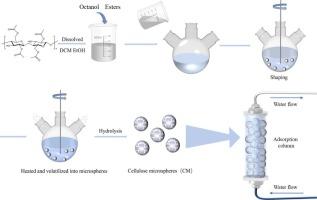用于染料柱吸附的可调孔纤维素微球吸附剂
IF 12.5
1区 化学
Q1 CHEMISTRY, APPLIED
引用次数: 0
摘要
纤维素微球的孔隙结构对其吸附性能起着至关重要的作用,但如何用一种简单、经济的方法控制其孔隙大小和分布仍然是一个挑战。在这里,通过调整纤维素溶液中二乙酸乙二醇与正辛醇的体积比,我们以一种简单而可扩展的方法制备了孔径从微米到纳米级可调节的纤维素微球。结果表明,纤维素微球的平均孔径控制在4.58 ~ 108.43 nm之间,孔径中位数在1.63 ~ 7.69 nm之间。纤维素微球对亚甲基蓝染料具有良好的静态和动态吸附性能,最大吸附量为20.6 mg/g。通过拟合Langmuir等温线模型,揭示了其单层吸附机理。有趣的是,纤维素微球具有与吸附树脂相当的抗压强度,其最大压应力范围为5.25至52.1 MPa,使其能够在吸附柱中填充。其中,柱吸附法的去除率为94.1%。纤维素微球具有孔径可调、力学性能好、吸附性能好等特点,将加速其在环境修复中的实际应用。本文章由计算机程序翻译,如有差异,请以英文原文为准。

Tunable-pore cellulose microsphere adsorbents for column adsorption of dyes
The pore structure of cellulose microspheres is vital for their adsorption performance, however it is still challenge to control pore size and their distribution by a simple and cost-effective method. Here, through adjusting volume ratios of ethylene glycol diacetate to n-octanol in the cellulose solution, we prepare cellulose microspheres with adjustable pore size ranging from the micron- to nanometer scale in a straightforward and scalable method. We show that the average diameter of pores in cellulose microspheres is controlled from 4.58 μm to 108.43 nm with the median of pore diameter being from 1.63 μm to 7.69 nm. Cellulose microspheres exhibited good performance in both static and dynamic adsorption of methylene blue dye with a maximum capacity of 20.6 mg/g. A monolayer adsorption mechanism is revealed through fitting the Langmuir isotherm model. Interestingly, cellulose microspheres exhibit compressive strength comparable to that of adsorption resins, with maximum compressive stress ranging from 5.25 to 52.1 MPa, enabling them to pack in adsorption columns. Notably, a removal efficiency of 94.1 % was achieved by using column adsorption. Cellulose microspheres show adjustable pore size, good mechanical properties, and good adsorption performance, which will accelerate their practical applications in the environmental remediation.
求助全文
通过发布文献求助,成功后即可免费获取论文全文。
去求助
来源期刊

Carbohydrate Polymers
化学-高分子科学
CiteScore
22.40
自引率
8.00%
发文量
1286
审稿时长
47 days
期刊介绍:
Carbohydrate Polymers stands as a prominent journal in the glycoscience field, dedicated to exploring and harnessing the potential of polysaccharides with applications spanning bioenergy, bioplastics, biomaterials, biorefining, chemistry, drug delivery, food, health, nanotechnology, packaging, paper, pharmaceuticals, medicine, oil recovery, textiles, tissue engineering, wood, and various aspects of glycoscience.
The journal emphasizes the central role of well-characterized carbohydrate polymers, highlighting their significance as the primary focus rather than a peripheral topic. Each paper must prominently feature at least one named carbohydrate polymer, evident in both citation and title, with a commitment to innovative research that advances scientific knowledge.
 求助内容:
求助内容: 应助结果提醒方式:
应助结果提醒方式:


